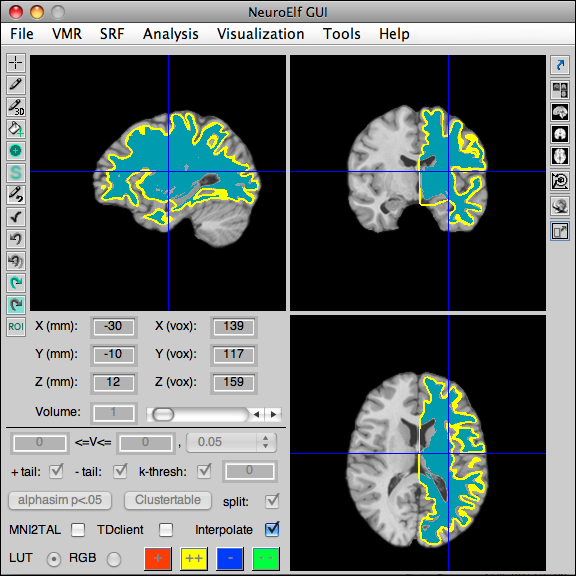Table of Contents
srf.BackToVMR
Motivation
After creating/morphing a surface, it is often helpful to visualize in a voxel-based representation where the vertices (and triangular planes inbetween) are located in space. This method allows to do so by creating either a 1mm- or a 0.5mm- resolution dataset which can then be sampled (or merged with a VMR, the original purpose).
Requirements
You simply need the surface object you wish to visualize in voxel space.
Method reference ('srf.Help('BackToVMR')')
SRF::BackToVMR - back-project vertices to VMR space
FORMAT: [srf = ] srf.BackToVMR([opts])
Input fields:
opts optional settings
.fillmode either of {'nearest'} or 'linear'
.nfrom Vertex + from * Normal (default: -0.25)
.nstep step along normal(default: 0.5)
.nto Vertex + to * Normal (default: nfrom + nstep)
.res VMR resolution, either of {1} or 0.5
.triovsmp triangular oversampling factor (default: 2)
Output fields:
srf SRF object with VertexVMRData set accordingly
Options
Options are passed as a struct. In the default case, a clearly visible layer (between one and two voxels usually) will be drawn. Depending on the mesh resolution, you might want to increase the triangle oversampling factor, for instance.
.fillmode
The fillmode determines how the VMR values will be filled. For nearest, each determined coordinate (vertex + multiplied normal vector, potentially triangular subsampled), will be rounded off and the resulting voxel will be set to a fixed value. For linear, the determined position will be distributed to all 8 adjacent voxel coordinates (box corners), according to the proximity of the determined position.
.nfrom, .nstep, and .nto
These three parameters determine how many sampling passes are performed and how far along the normal vector the sampling occurs. This is helpful if you wish to fill a thicker layer in voxel space, e.g. for creating a mask that covers more space.
.res
In case you are working in 0.5mm resolution (BrainVoyager's advanced segmentation), you can switch to that resolution (in which case you might want to increase the triangular oversampling factor as well, see below!).
.triovsmp
This parameter sets the triangular oversampling factor. The higher this value is, the more points within each triangle will be sampled. For example, with an oversampling factor of 5, each side of the triangle is split 5-fold and the meeting points of the parallel lines will be sampled.
Output example
This image represents the ICBM normalized left-hemisphere (radiological convention!) display of the colin_LH_ICBMnorm.srf file overlaid on the colin_brain_ICBMnorm.vmr (using a 6-times oversampling in triangles to cope with differences in triangle size). The interior has then been flood-filled with a code of 240 for voxels in the range 150 through 225.

